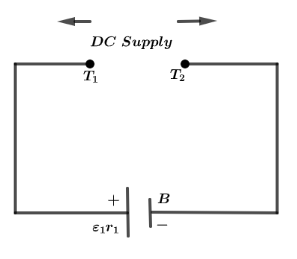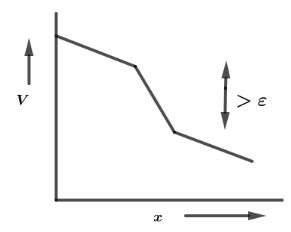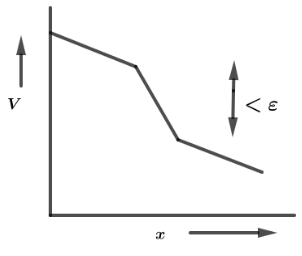
The connecting wires have uniform resistance. Moving from \[{T_1}\] to ${T_2}$ through $B$, the potential $(V)$ is plotted against distance $(x)$ . The correct curve is:

A.

B.

C.

D.






Answer
507.6k+ views
Hint: In order to solve this question, we need to check the sign of potential across the path if potential is from positive to negative terminal while moving from one point to another then graph will have negative slope while DC stands for Direct current and DC voltage always remains constant.
Complete step by step answer:
Firstly we will see the polarity of potential while moving from point ${T_1}$ to point ${T_2}$ so, on moving from ${T_1}$ to ${T_2}$ through point $B$, there must be drop in potential as we are moving from positive terminal to negative terminal of the battery as we can see in the given diagram. So, there must be a negative slope in the first case.But from the given option we can see that option C and option D have positive slope which is wrong hence, graphs in option C and D are not possible.
We also know that the DC supply has higher voltage than the battery shown, since the potential is very high at ${T_1}$ as compared to ${T_2}$ then potential drop across battery $B$. So, there will be further decrease in potential while moving from ${T_1}$ to ${T_2}$ through $B$ .
And in the last step there will be further decrease in potential across the battery due to its internal resistance $r$, so the drop of potential along battery at $B$ will be greater than $\varepsilon $. Hence, these conditions are best described by the graph given in option A.
So, the correct option is A.
Note: Direct current DC supply only flows in one direction unlike AC which has continuous waveform supply at different frequencies. Internal resistance of a battery is the opposition to the flow of current within the battery which is also responsible for decrease in potential difference of a battery, the main reason for internal resistance is due to ionic resistance inside the battery.
Complete step by step answer:
Firstly we will see the polarity of potential while moving from point ${T_1}$ to point ${T_2}$ so, on moving from ${T_1}$ to ${T_2}$ through point $B$, there must be drop in potential as we are moving from positive terminal to negative terminal of the battery as we can see in the given diagram. So, there must be a negative slope in the first case.But from the given option we can see that option C and option D have positive slope which is wrong hence, graphs in option C and D are not possible.
We also know that the DC supply has higher voltage than the battery shown, since the potential is very high at ${T_1}$ as compared to ${T_2}$ then potential drop across battery $B$. So, there will be further decrease in potential while moving from ${T_1}$ to ${T_2}$ through $B$ .
And in the last step there will be further decrease in potential across the battery due to its internal resistance $r$, so the drop of potential along battery at $B$ will be greater than $\varepsilon $. Hence, these conditions are best described by the graph given in option A.
So, the correct option is A.
Note: Direct current DC supply only flows in one direction unlike AC which has continuous waveform supply at different frequencies. Internal resistance of a battery is the opposition to the flow of current within the battery which is also responsible for decrease in potential difference of a battery, the main reason for internal resistance is due to ionic resistance inside the battery.
Recently Updated Pages
A man running at a speed 5 ms is viewed in the side class 12 physics CBSE

The number of solutions in x in 02pi for which sqrt class 12 maths CBSE

State and explain Hardy Weinbergs Principle class 12 biology CBSE

Write any two methods of preparation of phenol Give class 12 chemistry CBSE

Which of the following statements is wrong a Amnion class 12 biology CBSE

Differentiate between action potential and resting class 12 biology CBSE

Trending doubts
What are the major means of transport Explain each class 12 social science CBSE

Which are the Top 10 Largest Countries of the World?

Draw a labelled sketch of the human eye class 12 physics CBSE

Explain sex determination in humans with line diag class 12 biology CBSE

Explain sex determination in humans with the help of class 12 biology CBSE

Differentiate between homogeneous and heterogeneous class 12 chemistry CBSE




